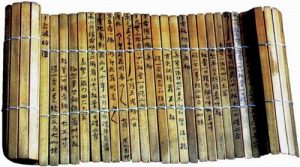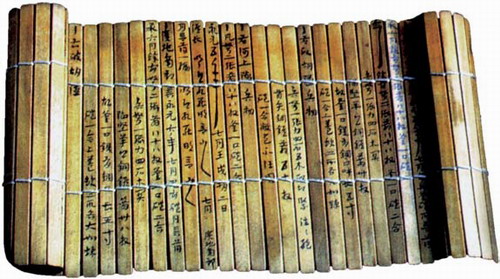The ancient Chinese scrolls are an evergreen way of remembering how people used to communicate in the early ancient times. A scroll is a roll of papyrus, parchment, or paper which has been written, drawn or painted upon for the purpose of transmitting information or using as a decoration.

It is distinguished from a roll by virtue of being intended for repeated use rather than continuous, but the once-only use of the roll. The hand-painted scroll is one example of how art was used to communicate in ancient China.
The format used for Chinese paintings varied widely over time.
Massive wall paintings, free-standing screens, horizontal and vertical scrolls, were some of the formats used. The horizontal hand scroll unrolled from right to left, giving the viewer a chance to look at one segment at a time. The horizontal handscroll was like a picture story book, and lead to the shorter vertical hanging scroll.
Silk was usually used to make scrolls until the invention of paper, traditionally thought to have been invented in China in the first century AD. Silk is not very absorbent, which led to the practice of slow and deliberate application of paint and ink.
Early paper was made from a variety of substances such as rice straw, bark, reeds, bamboo, etc. These early papers were more absorbent and led to more spontaneously created paintings. Most modern wall scrolls are painted on Xuan paper, also known as rice paper.
A wooden dowel is attached to the bottom of the scroll to prevent it from rolling up, and a thin piece of wood with a cord is placed at the top to hang the scroll from. Some Ancient Chinese Scrolls have silk backing or edges on them, but few are actually painted on silk.
Furthermore, Vertical hanging scrolls were suspended on walls and gave the viewer an opportunity to get close up and examine the details of the painting, and to back up and take the entire picture.
Scrolls were taken down periodically, with different scrolls replacing them. The Chinese have long thought of a magical link between mankind and the landscape, so many of the early hanging scrolls were landscapes, with other subjects added over the years.
A Chinese painting is judged on how the theme of the painting balances with the rest of the picture, and the feelings it evokes. The subject matter itself is sometimes secondary.
Chinese scroll paintings are wondrous creations of art, full of meaning, and give joy to the eye and soul. When you view a hand painted Chinese scroll you view thousands of years of history, practice, and artistry.
The oldest dated printed book to survive is a 16-foot-long (4.9 m) Chinese Buddhist copy of the Diamond Sutra, dated 868. The ancient Chinese invented and perfected ‘Indian Ink’ for use in writing, including Ancient Chinese Scrolls.
Originally designed for blacking the surfaces of raised stone-carved hieroglyphics, the ink was a mixture of soot from pine smoke and lamp oil mixed with the gelatin of donkey skin and musk. The ink invented by the Chinese philosopher, Tien-Lcheu (2697 B.C.), became common by the year 1200 B.C.
